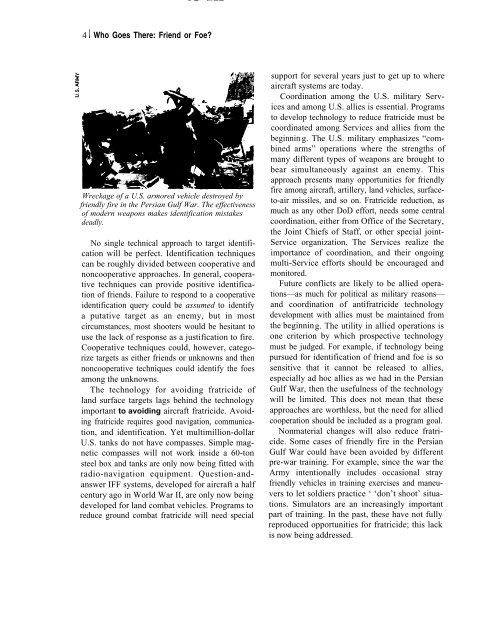Who Goes There: Friend or Foe? - Federation of American Scientists
Who Goes There: Friend or Foe? - Federation of American Scientists
Who Goes There: Friend or Foe? - Federation of American Scientists
You also want an ePaper? Increase the reach of your titles
YUMPU automatically turns print PDFs into web optimized ePapers that Google loves.
4 I <strong>Who</strong> <strong>Goes</strong> <strong>There</strong>: <strong>Friend</strong> <strong>or</strong> <strong>Foe</strong>?<br />
Wreckage <strong>of</strong> a U.S. arm<strong>or</strong>ed vehicle destroyed by<br />
friendly fire in the Persian Gulf War. The effectiveness<br />
<strong>of</strong> modern weapons makes identification mistakes<br />
deadly.<br />
No single technical approach to target identification<br />
will be perfect. Identification techniques<br />
can be roughly divided between cooperative and<br />
noncooperative approaches. In general, cooperative<br />
techniques can provide positive identification<br />
<strong>of</strong> friends. Failure to respond to a cooperative<br />
identification query could be assumed to identify<br />
a putative target as an enemy, but in most<br />
circumstances, most shooters would be hesitant to<br />
use the lack <strong>of</strong> response as a justification to fire.<br />
Cooperative techniques could, however, categ<strong>or</strong>ize<br />
targets as either friends <strong>or</strong> unknowns and then<br />
noncooperative techniques could identify the foes<br />
among the unknowns.<br />
The technology f<strong>or</strong> avoiding fratricide <strong>of</strong><br />
land surface targets lags behind the technology<br />
imp<strong>or</strong>tant to avoiding aircraft fratricide. Avoiding<br />
fratricide requires good navigation, communication,<br />
and identification. Yet multimillion-dollar<br />
U.S. tanks do not have compasses. Simple magnetic<br />
compasses will not w<strong>or</strong>k inside a 60-ton<br />
steel box and tanks are only now being fitted with<br />
radio-navigation equipment. Question-andanswer<br />
IFF systems, developed f<strong>or</strong> aircraft a half<br />
century ago in W<strong>or</strong>ld War II, are only now being<br />
developed f<strong>or</strong> land combat vehicles. Programs to<br />
reduce ground combat fratricide will need special<br />
supp<strong>or</strong>t f<strong>or</strong> several years just to get up to where<br />
aircraft systems are today.<br />
Co<strong>or</strong>dination among the U.S. military Services<br />
and among U.S. allies is essential. Programs<br />
to develop technology to reduce fratricide must be<br />
co<strong>or</strong>dinated among Services and allies from the<br />
beginnin g. The U.S. military emphasizes “combined<br />
arms” operations where the strengths <strong>of</strong><br />
many different types <strong>of</strong> weapons are brought to<br />
bear simultaneously against an enemy. This<br />
approach presents many opp<strong>or</strong>tunities f<strong>or</strong> friendly<br />
fire among aircraft, artillery, land vehicles, surfaceto-air<br />
missiles, and so on. Fratricide reduction, as<br />
much as any other DoD eff<strong>or</strong>t, needs some central<br />
co<strong>or</strong>dination, either from Office <strong>of</strong> the Secretary,<br />
the Joint Chiefs <strong>of</strong> Staff, <strong>or</strong> other special joint-<br />
Service <strong>or</strong>ganization. The Services realize the<br />
imp<strong>or</strong>tance <strong>of</strong> co<strong>or</strong>dination, and their ongoing<br />
multi-Service eff<strong>or</strong>ts should be encouraged and<br />
monit<strong>or</strong>ed.<br />
Future conflicts are likely to be allied operations—as<br />
much f<strong>or</strong> political as military reasons—<br />
and co<strong>or</strong>dination <strong>of</strong> antifratricide technology<br />
development with allies must be maintained from<br />
the beginning. The utility in allied operations is<br />
one criterion by which prospective technology<br />
must be judged. F<strong>or</strong> example, if technology being<br />
pursued f<strong>or</strong> identification <strong>of</strong> friend and foe is so<br />
sensitive that it cannot be released to allies,<br />
especially ad hoc allies as we had in the Persian<br />
Gulf War, then the usefulness <strong>of</strong> the technology<br />
will be limited. This does not mean that these<br />
approaches are w<strong>or</strong>thless, but the need f<strong>or</strong> allied<br />
cooperation should be included as a program goal.<br />
Nonmaterial changes will also reduce fratricide.<br />
Some cases <strong>of</strong> friendly fire in the Persian<br />
Gulf War could have been avoided by different<br />
pre-war training. F<strong>or</strong> example, since the war the<br />
Army intentionally includes occasional stray<br />
friendly vehicles in training exercises and maneuvers<br />
to let soldiers practice ‘ ‘don’t shoot’ situations.<br />
Simulat<strong>or</strong>s are an increasingly imp<strong>or</strong>tant<br />
part <strong>of</strong> training. In the past, these have not fully<br />
reproduced opp<strong>or</strong>tunities f<strong>or</strong> fratricide; this lack<br />
is now being addressed.
















